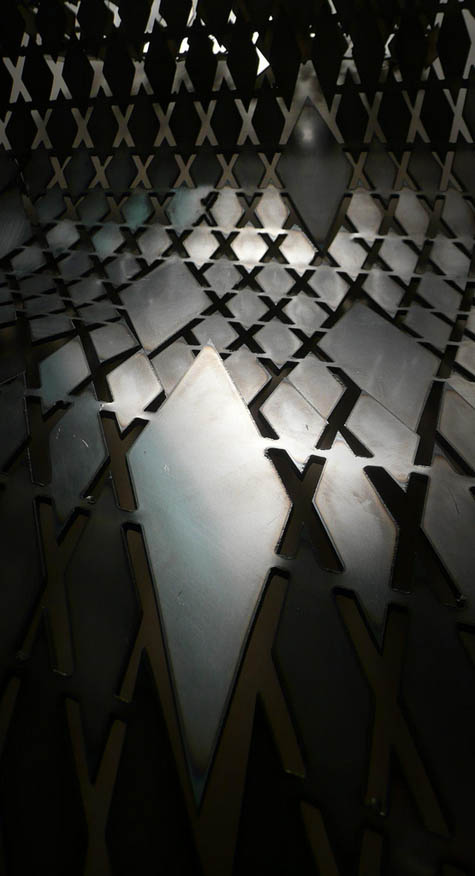Surface/Structure/Fold
 [Image: An absurdly beautiful photo of laser-cut steel by Elijah Porter, a student at the Yale School of Architecture].
[Image: An absurdly beautiful photo of laser-cut steel by Elijah Porter, a student at the Yale School of Architecture].Elijah Porter, a student at the Yale School of Architecture, has a great Flickr set up called Material Formation in Design. It features several awesome examples of how strategic cutting can transform a solid surface into a porous structure.
In the specific case of the image featured above, you're looking at what might be called subtractive origami, wherein diamond-shaped cuts have introduced foldability and mesh into a solid sheet of steel.
How interesting to think that, with just the right geometry of cuts and slices, you could activate the otherwise overlooked – or even unknown – baroque possibilities of a given material. You could even hold annual slice-design competitions, where students and mathematicians from around the world get together to display their secrets of cutting; one at a time, they program precise geometries into a laser-cutting machine, and whoever thereby achieves the most complex form, or the largest volume of folded space, wins.
Huge, 8' x 8' sheets of steel are turned into spheres and waveforms, in a kind of arabesque of wounding through which metal becomes lace.
One year, a student from Amsterdam blows everyone away by introducing just one, incredibly complex cut... and the whole sheet rolls up to the size of a one-inch ball.
Or you obtain a truck-mounted laser and a grant from the Graham Foundation, and you proceed to cut a new, gridded faultwork into the bedrock of the continent – perforation on the scale of whole landscapes – so that the geography you're standing on simply folds up and disappears.
Check out the rest of Porter's Flickr set here.





Comments are moderated.
If it's not spam, it will appear here shortly!
Very beautiful, almost organic, yet not!!! cheers to the great work!
Best...
Plus a second competition using the waste from the initial slicing
Brilliant! Would be great if we had the capacity to do this kind of cutting here at Upenn's School of Architecture - have been working on similar material investigations - slightly more irregular perhaps - but interested in corrosion patterns generated through effecting metal and the weathered transformation that would be revealed slowly over time.. sped up the process for the panel shown here...
http://www.flickr.com/photos/lift9/sets/72157616758320268/
For a quicker link.. didn't realize could insert the link directly
Corrosion Patterns
Elijah Porter's Flickr set is awesome - thanks for sharing
Traff
awesome
Post a Comment